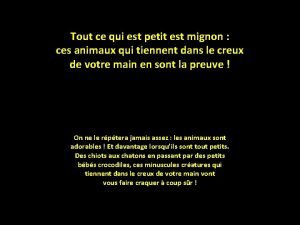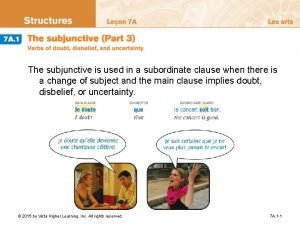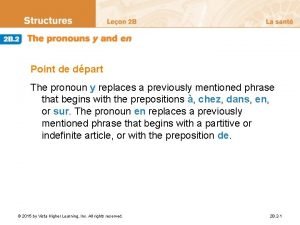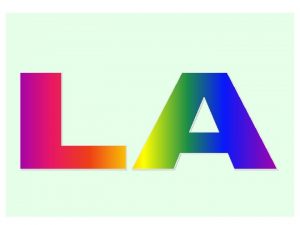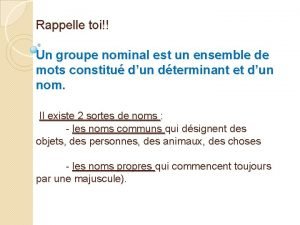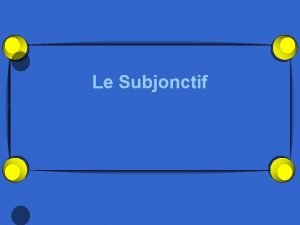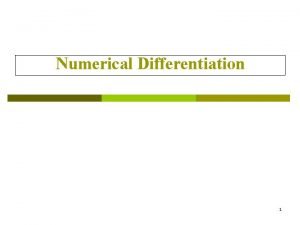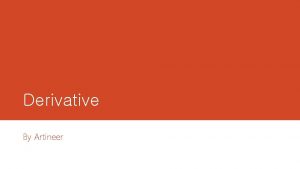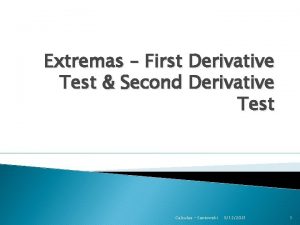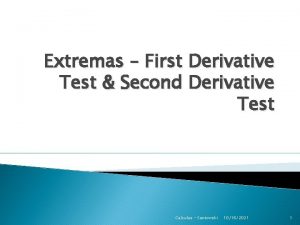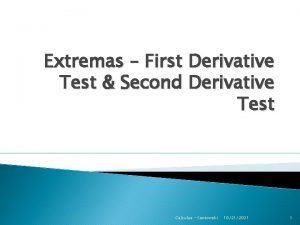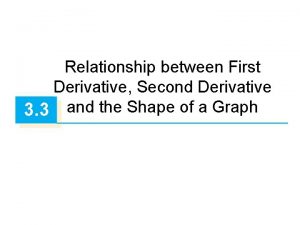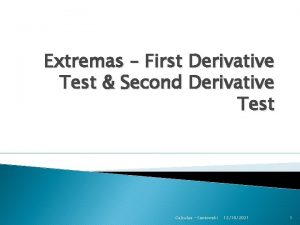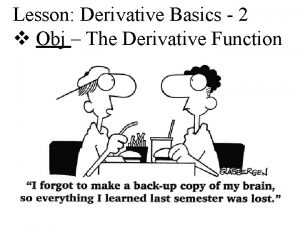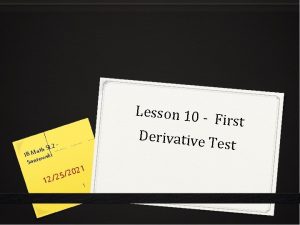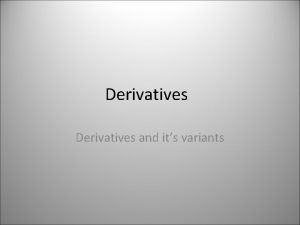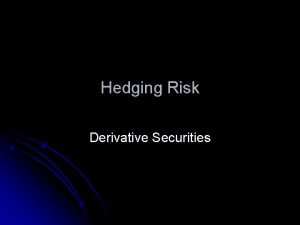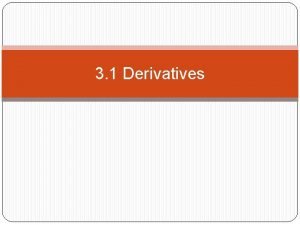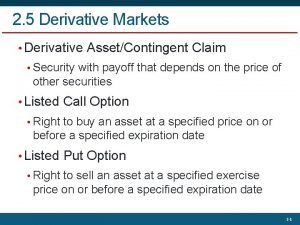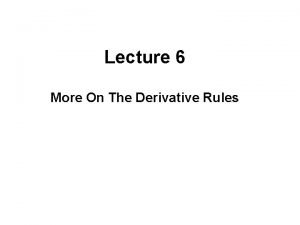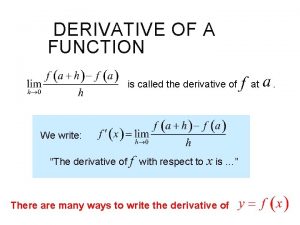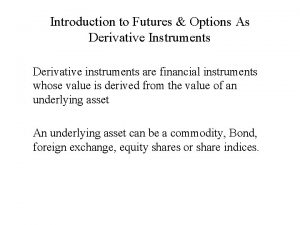Lesson 56 First Derivative T est h SL


















- Slides: 18

Lesson 56 First Derivative T est h SL 1 t a IB M wski o Sant 21 0 2 / 2/20 1

(A) Terms 0 Given a function, f(x), that is defined on a given interval and let c be a number in the domain 0 f(c) is the ABSOLUTE or GLOBAL maximum of f(x) on the interval if f(c) > f(x) for every x in the interval 0 Now, sketch an example of what has just been described. 2/20/2021 IB Math SL 1 - Santowski 2

(A) Terms 0 Given a function, f(x), that is defined on a given interval and let c be a number in the domain 0 f(c) is the ABSOLUTE or GLOBAL minimum of f(x) on the interval if f(c) < f(x) for every x in the interval 0 Now, sketch an example of what has just been described. 2/20/2021 IB Math SL 1 - Santowski 3

(A) Important Terms Recall the following terms as they were presented in a previous lesson: turning point: points where the direction of the function changes maximum: the highest point on a function minimum: the lowest point on a function local vs absolute: a max can be a highest point in the entire domain (absolute) or only over a specified region within the domain (local). Likewise for a minimum. 0 increase: the part of the domain (the interval) where the function values are getting larger as the independent variable gets higher; if f(x 1) < f(x 2) when x 1 < x 2; the graph of the function is going up to the right (or down to the left) 0 decrease: the part of the domain (the interval) where the function values are getting smaller as the independent variable gets higher; if f(x 1) > f(x 2) when x 1 < x 2; the graph of the function is going up to the left (or down to the right) 0 "end behaviour": describing the function values (or appearance of the graph) as x values getting infinitely large positively or infinitely large negatively or approaching an asymptote 0 0 0 2/20/2021 IB Math SL 1 - Santowski 4

(B) Review – Graphic Analysis of a Function 0 We have seen functions analyzed given the criteria intervals of increase, intervals of decrease, critical points (AKA turning points or maximum or minimum points) 0 We have also seen graphically how the derivative function communicates the same criteria about a function these points are summarized on the next slide: 2/20/2021 IB Math SL 1 - Santowski 5

(B) Review – Graphic Analysis of a Function 0 f(x) has a max. at x = -3. 1 and f `(x) has an x-intercept at x = -3. 1 0 f(x) has a min. at x = -0. 2 and f `(x) has a root at – 0. 2 0 f(x) increases on (- , -3. 1) & (-0. 2, ) and on the same intervals, f `(x) has positive values 0 f(x) decreases on (-3. 1, -0. 2) and on the same interval, f `(x) has negative values 2/20/2021 IB Math SL 1 - Santowski 6

(C) Analysis of Functions Using Derivatives – A Summary 0 If f(x) increases, then f `(x) > 0 0 If f(x) decreases, then f `(x) < 0 0 At a max/min point, f `(x) = 0 0 We can also state the converse of 2 of these statements: 0 If f `(x) > 0, then f(x) is increasing 0 If f `(x) < 0, then f(x) is decreasing 0 The converse of the third statement is NOT true if f `(x) = 0, then the function may NOT necessarily have a max/min so for now, we will call any point that gives f `(x) = 0 (i. e. produces a horizontal tangent line) a CRITICAL POINTS or EXTREME POINTS 2/20/2021 IB Math SL 1 - Santowski 7

(D) First Derivative Test 0 So if f `(x) = 0, how do we decide if the point at (x, f(x)) is a maximum, minimum, or neither (especially if we have no graph? ) 0 Since we have done some graphic analysis with functions and their derivatives, in one sense we already now the answer: see next slide 2/20/2021 IB Math SL 1 - Santowski 8

(E) First Derivative Test - Graphically 0 At the max (x = -3. 1), the fcn changes from being an increasing fcn to a decreasing fcn the derivative changes from positive values to negative values 0 At a the min (x = -0. 2), the fcn changes from decreasing to increasing the derivative changes from negative to positive 2/20/2021 IB Math SL 1 - Santowski 9

(F) First Derivative Test - Algebraically 0 At a maximum, the fcn changes from being an increasing fcn to a decreasing fcn the derivative changes from positive values to negative values 0 At the minimum, the fcn changes from decreasing to increasing the derivative changes from negative to positive 0 So to state the converses: 0 If f `(x) = 0 and f the sign of if `(x) changes from positive to negative, then the critical point on f(x) is a maximum point 0 If f `(x) = 0 and f the sign of if `(x) changes from negative to positive, then the critical point on f(x) is a minimum point 0 So therefore, if the sign on f `(x) does not change at the critical point, then the critical point is neither a maximum or minimum we will call these points STATIONARY POINTS 2/20/2021 IB Math SL 1 - Santowski 10

(G) First Derivative Test – Example #1 0 Find the local max/min values of y = x 3 - 3 x + 1 (Show to use inequalities to analyze for the sign change) 0 0 0 f `(x) = 3 x 2 – 3 f `(x) = 0 for the critical values 0 = 3 x 2 – 3 0 = 3(x 2 – 1) 0 = 3(x – 1)(x + 1) x = 1 or x = -1 0 Now, what happens on the function, at x = + 1? let’s set up a chart to se what happens with the signs on the derivative so that we can determine the sign on the derivative so that we can classify the critical points 2/20/2021 IB Math SL 1 - Santowski 11

(G) First Derivative Test – Example #1 Factor 3 (x-1) (x+1) f `(x) f(x) (-∞, -1) + - - + inc (-1, 1) + - dec (1, ∞) + + inc Interval 2/20/2021 IB Math SL 1 - Santowski 12

(G) First Derivative Test – Example #1 0 Since the derivative changes signs from +ve to –ve, the critical point at x = -1 is a maximum (the original function changing from being an increasing fcn to now being a decreasing fcn) 0 Since the derivative changes signs from -ve to +ve, the critical point at x = 1 is a minimum (the original function changing from being a decreasing fcn to now being an increasing fcn) 0 Then, going one step further, we can say that f(-1) = 3 gives us a maximum value of 3 and then f(1) = -1 gives us a minimum value of -1 0 And going another step, we can test the end behaviour of f(x): 0 lim x -∞ f(x) = -∞ 0 lim x ∞ f(x) = +∞ 0 Therefore, the point (-1, 3) represents a local maximum (as the fcn rises to infinity “at the end”) and the point (1, -1) represents a local minimum (as the fcn drops to negative infinity “at the negative end”) 2/20/2021 IB Math SL 1 - Santowski 13

(G) First Derivative Test – Example #1 – Graphic Summary 2/20/2021 IB Math SL 1 - Santowski 14

(H) In Class Examples 0 Ex 2. Find the local max/min values of g(x) = x 4 - 4 x 3 - 8 x 2 - 1 0 Ex 3. Find the absolute minimum value of f(x) = x + 1/x for x > 0 2/20/2021 IB Math SL 1 - Santowski 15

(I) More Examples 0 Determine the absolute extrema for the following function and interval: 0 g(x) = 2 x 3 + 3 x 2 – 12 x + 4 on [-4, 2] 0 f(x) = x 4 – 4 x 3 + 4 x 2 0 f(x) = x 4 – 4 x 3 0 f(x) = 3 x 5 - 25 x 3 + 60 x 0 f(x) = 3 x 4 - 16 x 3 + 18 x 2 + 2 2/20/2021 IB Math SL 1 - Santowski 16

(J) Internet Links 0 Visual Calculus - Maxima and Minima from UTK 0 Visual Calculus - Mean Value Theorem and the First Derivative Test from UTK 0 First Derivative Test -- From Math. World 0 Tutorial: Maxima and Minima from Stefan Waner at Hofstra U 0 http: //www. math. hmc. edu/calculus/tutorials/extre ma/ 2/20/2021 IB Math SL 1 - Santowski 17

(K) Homework 0 Handout from Stewart, 1997, text 2/20/2021 IB Math SL 1 - Santowski 18
 Tout ce qui est petit est mignon explication
Tout ce qui est petit est mignon explication Il est douteux que le metteur en scène où est l’acteur.
Il est douteux que le metteur en scène où est l’acteur. Le marcassin est au sanglier ce que le levraut est
Le marcassin est au sanglier ce que le levraut est Papa est au garage? oui, il
Papa est au garage? oui, il Chant alleluia christ est vivant
Chant alleluia christ est vivant Je sui tu es il est
Je sui tu es il est Qu'est ce que c'est
Qu'est ce que c'est Total float= * 1 point lst-est lst-eft est-lft eft-lst
Total float= * 1 point lst-est lst-eft est-lft eft-lst Seul le silence est grand
Seul le silence est grand Mon dieu tu es grand tu es beau paroles
Mon dieu tu es grand tu es beau paroles Mon dieu tu es grand tu es beau parole
Mon dieu tu es grand tu es beau parole Je suis tu es elle est
Je suis tu es elle est Gilles vigneault mon pays
Gilles vigneault mon pays Qu'est ce que c'est
Qu'est ce que c'est Ce n'est pas une image juste c'est juste une image
Ce n'est pas une image juste c'est juste une image Groupe nomiaux
Groupe nomiaux Verbes d etat
Verbes d etat Verbes qui exigent le subjonctif
Verbes qui exigent le subjonctif Numerical differentiation
Numerical differentiation
